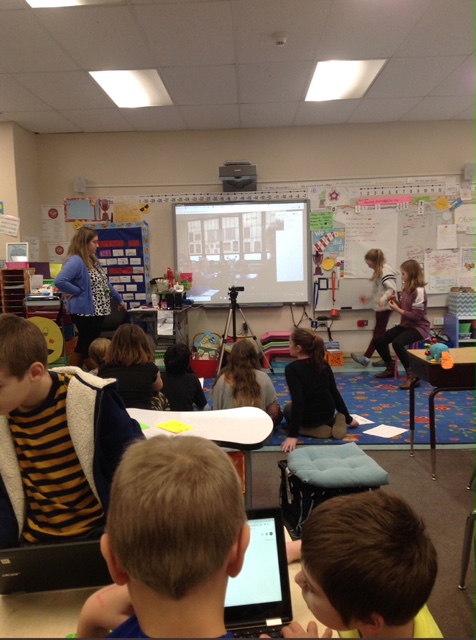Students in Courtney Elliott’s class work on a Mystery Skype with a class in Wisconsin to demonstrate communication skills and content knowledge of the U.S regions.
Inquiry question about personalized learning: How might personalization through self-reflection, self-assessment, and flexible grouping and scheduling across grades 3 and 4 at Proctor Elementary School positively impact student engagement and achievement?
Bright Spot: Some days I feel like I am a rock star educator; other days I feel like a complete mess. And through this journey I am learning that it is not only possible but okay to be both.
This journey over the last three years to a student-centered, fully differentiated classroom has been quite the ride. It started with project based learning and a creative group of 4th and 5th graders and has led to here, where we are now with a group of fourth graders who are learning so many life skills through this model.
This leads us to the bright spots… those days when I feel like a rockstar educator. These moments come from my students and their ability to work in ways that I could never have dreamed of when they first walked through that fourth grade door in September. This year we have focused on helping our third and fourth graders to make choices about what they need to be successful in their learning through helping them to evaluate where they are and what they need.
This model ties in well with the idea of universal design: the idea that all children can be successful in the general education classroom by providing access points for every child’s entry into the grade level curriculum no matter where they are. Simply stated, meeting each child where he or she is at this point in their learning.
Last year, my class was visited by representatives from an inclusive classroom program. Turns out we were selected with two other schools in Vermont to serve as an inclusion model. This fall, my classroom was chosen as a model for inclusive design. This has been my passion since I started teaching and this was a bright spot in my journey. That this student-centered model, where third and fourth grade share students based on need and proficiency skills, has helped to foster and create an inclusive classroom for all students.
Sitting here grading math assessments and all I can say is WOW! This new model we have implemented with learning lab and @VTCoreySmith is working. I’ve never had so many kids meet and exceed in this unit before! #choicemenus #flexiblegrouping @ProctorSchool @rhlearning @hennesss
— Courtney Elliott (@MsElliott345) February 2, 2019
Belly Flop: Now for that belly flop or that dilemma that I feel like I am facing moving forward…those days I feel like a hot mess educator. Those days I go home wondering if in the long run I am failing my students.
What happens when eventually these students are placed in classrooms that fit the more traditional boxes?
What happens when the only access point for them in the classroom is a one size fits all curriculum for all students?
I worry about if what I am doing is best preparing my students. I worry that if having them work at their own level at the skill and not teaching to a program will hurt them in the long run. For example, will allowing students to make choices to guide their own learning affect them in a traditional classroom setting because they will not be able to be at their pace?Yes, on their benchmark assessments they may move from a first grade math level to a third grade math level but what happens when they are expected to complete a fifth grade math curriculum? I worry about if by allowing them to make choices in the classroom based on need they are not learning what they will need to prepare for future endeavors in education.
Students apply for independent math study for Throwback Thursday @ProctorSchool! @VTCoreySmith pic.twitter.com/ctLvrtnZvd
— Courtney Elliott (@MsElliott345) March 6, 2019
So in conclusion, I feel like I am in a place of limbo with my classroom environment and pedagogy. I know in my heart that this learning is right for my kids. I see the progress in the benchmark data and their joy and engagement with learning on a daily basis. For example, Corey and I have had several conversations with students around their learning and what helps them learn best.
Platypodcast #2 on Choice Menus – what they are, how we use them in 3rd and 4th, and how they impact our learning #vted #grcsu #pres @ProctorSchool @MsElliott345 @LearnerBased https://t.co/zKBuZb5Mmr
— Corey Smith (@VTCoreySmith) February 12, 2019
The data collected from these meetings or check ins is that they enjoy choice and setting goals. They feel comfortable working at their own pace and seeing where they are in their learning of the skill through the use of checklists and rubrics. They like to feel empowered and like they are in charge.
Corey and I hope to create a student engagement survey after break to further highlight what the students have said in these classroom discussions. Still, I have those days where I just wonder that once they leave my classroom and continue on their educational journey that I have made the road harder for them in some way. It’s a lot to think about, but aIl I know is my heart tells me that I am doing the right thing. I just need to remember that.


